Courses: The GoldSim Contaminant Transport Module:
Unit 3 - Introduction to Contaminant Transport Modeling Using GoldSim
Lesson 10 - Basic Concepts of Contaminant Transport Modeling Using GoldSim
We are now (finally!) ready to start actually discussing how the GoldSim Contaminant Transport Module can be used to build contaminant transport models. We have taken a somewhat circuitous route to get here (describing the various processes GoldSim can simulate, how those processes are represented mathematically, why uncertainty is such an important issue, and the overall GoldSim modeling philosophy). However, this is necessary in order for you to fully understand why GoldSim is designed the way it is. That is, as pointed out previously, in order for you to build effective contaminant transport models in GoldSim, it is necessary for you to fully understand (and “buy into”) the philosophy on which GoldSim is based. Now that we have done so, we can start to discuss GoldSim in more concrete terms.
The first thing that is important to understand about the GoldSim Contaminant Transport Module is that it simply provides access to a number of additional elements (listed under the Contaminant Transport heading):
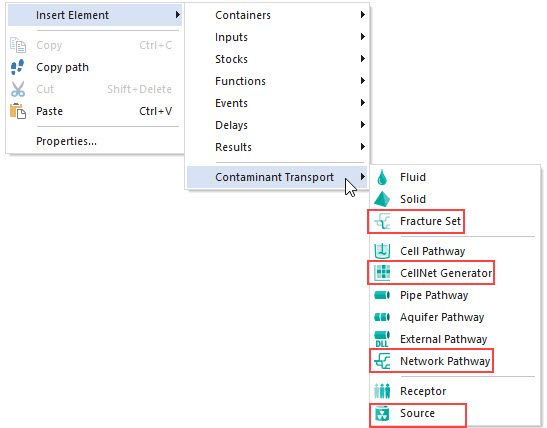
Note: The elements highlighted in red are only available in the RT Module, and not in the CT Module. The difference between these two modules was discussed in Unit 1, Lesson 4.
These elements are highly specialized. The elements associated with the basic GoldSim framework are intentionally very generic, and are designed to carry out basic mathematical operations (e.g., solving a time integral) that can be applied to a wide variety of problems. For example, a Reservoir element could be used to keep track of the volume of water in a pond, the number of people in a city, the amount of fuel in a tank, or the number of fish in a stream reach. The Contaminant Transport Module elements, on the other hand, are designed to be applied to a very specific (and complex) problem: tracking the fate and transport of mass through a system. As such, the elements are much more complex computationally. Interestingly, however, it could be argued that they are actually somewhat easier to learn to use! The reason for this is that by definition, their inputs and outputs are much more specific and therefore much less abstract. For example, while a Reservoir refers to inputs such as Initial Value and a Rate of Change (very generic inputs that could refer to water, people, fuel or fish), elements in the Contaminant Transport Module are much more physically based, referring to specific volumes, masses, lengths, areas and other very specific inputs.
Three elements can be thought of as highly specialized Data elements that are used to define the basic physical and chemical properties of the materials in the system:

The Species element is used to define a list of the contaminant species that you want to simulate (you can simulate an unlimited number). When you define a species, you also provide some of the properties of that species, such as its first-order decay rate (which, of course is optional), and if it does decay, any daughter product(s) that are produced (daughter products can be specified only if you have the RT Module). Recall that we discussed decay rates in Lesson 5. There is almost always only a single Species element in a GoldSim model (there are rare cases where you would have more than one that we will discuss in the final Unit).
The other two elements here represent media elements (which can be either Fluids or Solids). All models will have at least one Fluid (typically Water), and may have others (e.g., Air). Most models will also have one or more Solids. In the image above, there is one Fluid (named Water) and one Solid (named Sand). Media elements are used to specify physical and chemical properties, as shown below (this is the dialog for a Solid):
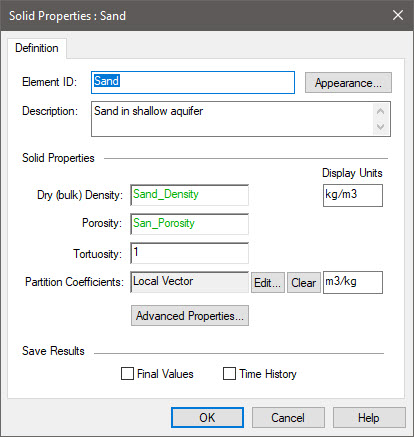
Some of these properties are specific to just the Solid (e.g., the porosity), while others represent properties of the various species with respect to that Solid (partition coefficients). For Fluids you specify things such as the diffusion coefficient and solubility for each species in that Fluid. Diffusion coefficients were discussed in Lesson 4 and partition coefficients and solubilities were discussed in Lesson 5.
Transport pathway elements are the key objects used to build contaminant transport models in GoldSim (and these are the elements that actually numerically solve the equations we discussed in previous Lessons in this Unit). Transport pathways represent physical components through which contaminant species can move and/or be stored, such as aquifers, lakes, sediments, surface soil compartments, and the atmosphere. You define the properties of the pathways, such as their geometry and which environmental media (e.g., water, soil, air) they contain. All pathways contain one or more environmental media.
GoldSim provides a number of different types of pathway elements. The most commonly used and the three that we will discuss in detail in this Course are the Cell, the Pipe and the Aquifer:

Earlier in this Unit we described two different types of components in a mass transport model: those that can be represented as well-mixed compartments, and those in which concentration varies continuously over space, with the governing equation defined in terms of a concentration gradient. Cell pathways are used to model the former (e.g., tanks, lakes, soil compartments), whereas Pipes and Aquifers are used to model the latter (e.g., aquifers, streams, pipelines). You create an environmental system by defining a network of transport pathways, as shown below:
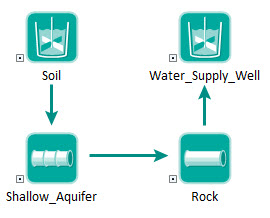
To create such a network, individual pathways are connected via mass flux links. A mass flux link is a special connection between pathways that defines the mechanisms by which species move between them. The two primary types of mass flux links represent advection and diffusion. In an advective mass flux link, a quantity of a medium is specified to flow from one pathway to another, carrying dissolved species and species sorbed on suspended species with it. In a diffusive mass flux link, species diffuse between pathways according to a concentration gradient. Other special purpose mass flux links allow you to model processes that cannot easily be represented using advection or diffusion.
Based on the properties of each pathway, the media in each pathway, the species, and the specified mass flux links, GoldSim computes the temporally varying concentrations in each pathway's media, as well as the mass fluxes between pathways. Hence, the fundamental output of a pathway element is as follows:
- the mass (of each species) in the pathway;
- the concentration (of each species) within each medium (fluids, solids) in the pathway; and
- the rate (for each species) at which mass is being passed to each of the pathways to which it is connected via mass flux links.
Of course, in order to build a contaminant transport model, mass must be introduced into the system. Within GoldSim, there are two ways to do this:
- An initial mass and/or a rate of addition of mass can be directly specified for one or more pathways in the system (and these of course, can be time-variable); and
- When using the RT Module (but not the CT Module), a specialized element (called a Source) can be used to define to properties of one or more sources, and based on their properties, GoldSim computes rates of release of mass from the source(s) to specified pathways. Source elements are designed to be used for engineered disposal systems such as radioactive waste disposal facilities.
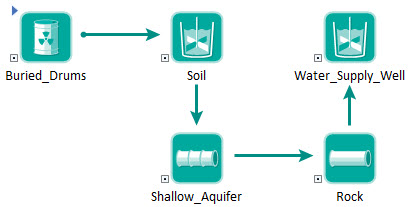
Finally, the objective of some contaminant transport studies is to not only compute contaminant concentrations or mass flux rates at various locations in the environment, but to also compute the impact of these contaminants on specific receptors (e.g., humans, wildlife, flora).
The Receptor element allows you to define specific receptors, and associate these with various pathways in your environmental system. The total impact to a receptor is then computed as the sum of the impacts associated with each pathway through which the receptor is exposed to the contaminant (e.g., drinking water from a well, breathing dust in the atmosphere, ingesting soil).
Impacts may be calculated as:
- ratios of contaminant concentrations to permissible limits (i.e., hazard quotients);
- health (e.g., cancer) risks; or
- radioactive doses.
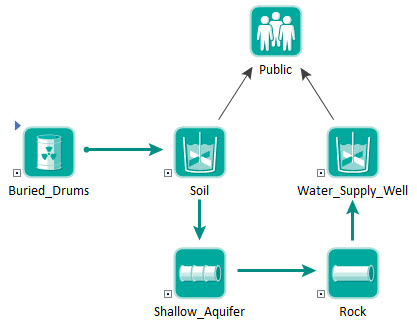
Starting in the next Unit, we will describe the use of all of these elements in great detail.
